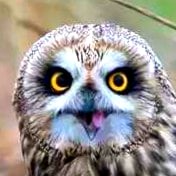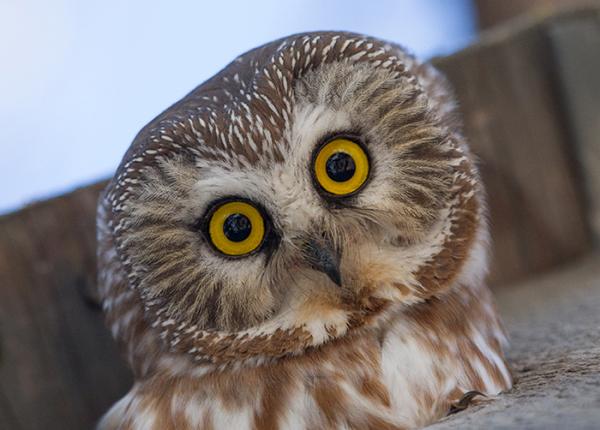The great horned owl right after the exam and getting that barbed wire removed. He was annoyed, but also exhausted.
And as mentioned yesterday, here is the update on the young Great Horned Owl who was tangled up in a barbed wire fence!
A couple noticed this owl dangling by one wing from the fence and thankfully jumped into action. They couldn’t safely untangle the owl themselves, so they had to cut the wire and get him in a box that way to get him to us.
The first thing I noticed besides the obvious wire was the fuzzy head - this is a chick that hatched this year. Likely he’s still learning to hunt on his own, and has parents looking for him, as they will keep supplementing their food into the fall. In his attempt to hunt and fly on his own he ran into the wire of the fence. While they have great eyesight, the wire can easily blend into the sticks and grasses and other things behind and if they are focused on something like a small rodent behind there they want to catch, it’s easy for them to not see it.
I checked the bird in and immediately took him back to our exam room to figure out how bad it was. As mentioned, sometimes barbed wire does extensive and unrepairable levels of damage, and if they are stuck there too long that can add to that.
The first thing I noticed was bruising, or really, lack thereof. This bird hadn’t been there long enough to really start bruising up yet. There was redness in the area, but this was obviously a VERY recent entanglement. He was extremely lucky to be noticed right away!
I started carefully working to get some of the tangled feathers loose and see what was going on. I used one of our raptor wraps to help keep the other wing tucked next to the body and the feet secure, and a towel over the head to help keep the young owl from having to see me towering over him while I worked, which could add fear and stress and might make him fight and thrash, making things worse.
After a lot of careful manipulation and cutting a few destroyed parts of the feathers away to get a better view, I found that it was just a single barb that had poked into the skin, and then gotten twisted around helping hold it in tighter. With some careful turning and pressure, I finally managed to pull that loose.
Checking the wing over after it was free of the wire, I was sure there would be a lot of bruising, but was happy to find no breaks, no degloving injury, and a couple flight feathers that were going to fall out from the ordeal but nothing that seemed extensive, and feathers do generally grow back regularly, so those should be replaced by the owl in time!
I very carefully cleaned the wound and area, gave the owl a dose of anti-inflammatory medication and pain medication and set him up in the hospital for the night to see how he was the next day.
The next day I was greeted by an angry, active, and healthy looking great horned! After giving a few more days to make sure everything was healing up well, I put a microchip in him for identification and moved him out into our Superflight with the other juvenile great horned owls we’ve gotten this year. (There are 8 great horned owls in here, with varying stages of fuzz on their head!)
The great horned has continued to heal, and EAT! Young great horned owls eat a lot of food as they develop, which helps them keep building the muscles for strong flight and hunting. I’ve managed to watch him fly around with the others, being able to pick him out because of the couple missing feathers in the wing, which aren’t slowing him down at all.
Hopefully in the next month or so we’ll be able to get all those youngsters, including this one, rechecked, banded, and released back to the wild where they belong - and hopefully avoid things like barbed wire!
We know barbed wire is important for many farmers with livestock to keep their animals secure, but when its not in needed use that way, if it can be removed that can go a long ways to preventing this from happening! This owl was very lucky, others are not so much. If barbed wire must stay, adding flagging tape or high- contrast caps can help birds avoid collisions.
We’re only able to take care of these birds, give them the food and medications they need to recover, and have this place for them to recover, because of our wonderful supporters. All of you were part of this, and helped to make sure this bird, and many others, have that second chance! Thank you for all your continued support and help.


Most owls are solitary, aren’t they? At what age do GHO stop being OK with being in an enclosure with other owls old this?
Most species are solitary. The parents will usually keep an eye on them and give them some help through the first year to make sure they get through that first winter. After that, the kids will go off and find their own territory.
For the enclosure like this, at least for where I am, flight enclosures are the last step before release, so hopefully nobody will be in here for too long. Since they don’t have their own territory yet, and they are fed regularly, I feel that probably keeps incidents down.
We have 2 Broadwing Hawks in a single enclosure now, and I was there when they were debating if it was ok to move them in together, and that was what most of that conversation boiled down to. Both had pretty decent attitudes, and if both were being fed, there wasn’t really much to fight over.
I have seen a few places where adults stay together though. I believe the Raptor Center in NJ had multiple adult looking Barred Owls together. Owls can identify each other by voice, so as long as they know it isn’t a stranger coming to take their stuff, that seems to go a long way to easing their stress.
That’s all my best somewhat educated thoughts anyway.
Barn owls seem to sleep in groups, at least, so I get it’s not universal. That makes sense about territory and feeding, though.